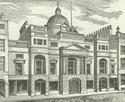 Remarkably no school or university buildings from this period survive, even though in 1816 there were 144 schools in the city with almost 17,000 scholars, of whom some 6,500 were taught in charity or free schools. Many of these schools were associated with religious denominations and were swept away when school education was reformed by the education act of 1872.
Remarkably no school or university buildings from this period survive, even though in 1816 there were 144 schools in the city with almost 17,000 scholars, of whom some 6,500 were taught in charity or free schools. Many of these schools were associated with religious denominations and were swept away when school education was reformed by the education act of 1872.
 During this period the University grew in size and numbers to the point that it was overflowing its site in the High Street. To provide more spacious accommodation the east range of the east quadrangle was demolished to make way for the more spacious classical Hamilton building. Completed in 1811, it was paid for by a bequest from John Hamilton, a merchant in Canton. An archway led east into the Museum Square where William Stark's handsome Hunterian Museum housed William Hunter's magnificent collection of books, manuscripts, coins, paintings and medical artifacts which he left to the University in 1783. To the south was a new Library completed in 1782. All these buildings were demolished when the University migrated to the west end in 1870.
During this period the University grew in size and numbers to the point that it was overflowing its site in the High Street. To provide more spacious accommodation the east range of the east quadrangle was demolished to make way for the more spacious classical Hamilton building. Completed in 1811, it was paid for by a bequest from John Hamilton, a merchant in Canton. An archway led east into the Museum Square where William Stark's handsome Hunterian Museum housed William Hunter's magnificent collection of books, manuscripts, coins, paintings and medical artifacts which he left to the University in 1783. To the south was a new Library completed in 1782. All these buildings were demolished when the University migrated to the west end in 1870.
 By 1830 there was another university in Glasgow, which had been founded by the will of Professor John Anderson in 1795. Teaching began in the Trades' Hall the following year and later moved to premises in John Street. In 1828 this university moved to the old Grammar School buildings in George Street which was extended and refurbished for its use. These were knocked down at the beginning of the 20th century to make way for the Glasgow and West of Scotland Technical College building, which still stands as part of the University of Strathclyde.
By 1830 there was another university in Glasgow, which had been founded by the will of Professor John Anderson in 1795. Teaching began in the Trades' Hall the following year and later moved to premises in John Street. In 1828 this university moved to the old Grammar School buildings in George Street which was extended and refurbished for its use. These were knocked down at the beginning of the 20th century to make way for the Glasgow and West of Scotland Technical College building, which still stands as part of the University of Strathclyde.